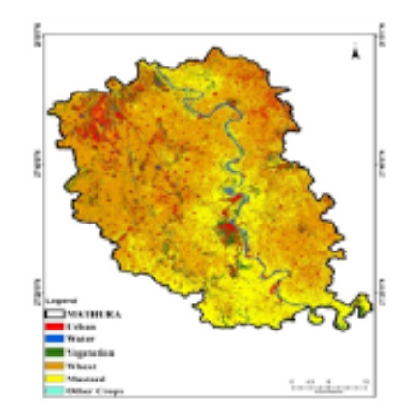


Indian Journal of Science and Technology
DOI: 10.17485/IJST/v16i46.2530
Year: 2023, Volume: 16, Issue: 46, Pages: 4456-4468
Original Article
Priyanka Gupta1*, Suraj Kumar Singh2, Prateek Gupta3, Shruti Kanga4, Varun Narayan Mishra5
1School of Engineering & Technology, Suresh Gyan Vihar University, Jaipur, Rajasthan, India
2Department of Centre for Sustainable Development, Suresh Gyan Vihar University, Jaipur, Rajasthan, India
3School of Computer Science, UPES, Dehradun, Uttarakhand, India
4Department of Geography, School of Environment and Earth Sciences, Central University of Punjab, Bathinda, Punjab, India
5Amity Institute of Geoinformatics and Remote Sensing (AIGIRS), Amity University, Noida, Uttar Pradesh, India
*Corresponding Author
Email: [email protected]
Received Date:06 October 2023, Accepted Date:19 October 2023, Published Date:20 December 2023
Objective: This study investigates the Spatial temporal changes of LULC in Mathura district of Uttar Pradesh, India, over the past 30 years (1990 to 2020). The study uses Landsat-5, Landsat-7 as well as Landsat-8 OLI images and GIS technique. Methods: The images are classified into LULC classes using a random forest classifier. The LULC changes are analyzed using a change detection analysis. The results of the change detection analysis were visualized using GIS. Confusion matrix is used for comparing the Crop classification during 1990–2020. User accuracy, consumer accuracy, producer accuracy, overall accuracy and kappa coefficient are used to compare the study of approximately three decades from 1990 to 2020. Findings: The classification of LULC is done into six classes i.e., urban, water bodies, vegetation, wheat, mustard and other crops. The results show that there are significant changes in LULC over the past 30 years. In the year 1990, 70.1 % accuracy and kappa 61.61 are obtained. In the year 2000, 70.8 % accuracy and kappa 63.02 are obtained. In the year 2010, 71.3% accuracy and kappa 64.8 is obtained. In the year 2020, 84% accuracy and kappa 80 are obtained. Novelty: In traditional mapping is not feasible, multi temporal satellite imagery can offer the crucial measurement of spatial and temporal phenomena for the research area. The study shows that the predominant land use in the area under investigation is vegetation. Less agricultural activity occurred between 2000 and 2010, which increased the amount of land covered by vegetation. The importance of monitoring LULC changes in order to understand the effects of these variations on the society as well as environment.
Keywords: Spatiotemporal changes, LULC, Landsat, GIS, agricultural expansion and urbanization
© 2023 Gupta et al. This is an open-access article distributed under the terms of the Creative Commons Attribution License, which permits unrestricted use, distribution, and reproduction in any medium, provided the original author and source are credited. Published By Indian Society for Education and Environment (iSee)
Subscribe now for latest articles and news.